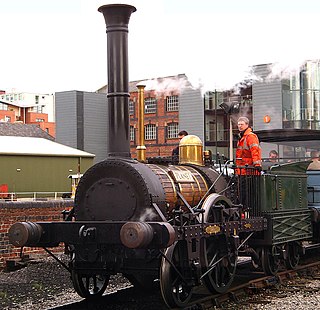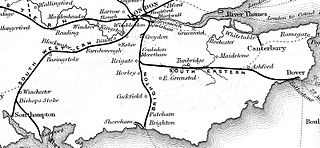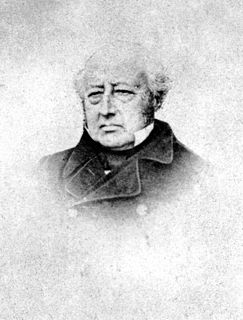
The Rainhill trials was an important competition run from the 6 to 14 October 1829, to test George Stephenson's argument that locomotives would have the best motive power for the then nearly-completed Liverpool and Manchester Railway (L&MR). Five locomotives were entered, running along a 1 mile (1.6 km) length of level track at Rainhill, in Lancashire.

Stephenson's Rocket is an early steam locomotive of 0-2-2 wheel arrangement. It was built for and won the Rainhill Trials of the Liverpool and Manchester Railway (L&MR), held in October 1829 to show that improved locomotives would be more efficient than stationary steam engines.

The Liverpool and Manchester Railway (L&MR) was the first inter-city railway in the world. It opened on 15 September 1830 between the Lancashire towns of Liverpool and Manchester in England. It was also the first railway to rely exclusively on locomotives driven by steam power, with no horse-drawn traffic permitted at any time; the first to be entirely double track throughout its length; the first to have a signalling system; the first to be fully timetabled; and the first to carry mail.

Edge Hill railway station is a railway station that serves the district of Edge Hill, Liverpool, England and is one of the oldest railway stations in the world

Under Whyte notation for the classification of steam locomotives, 2-2-0 represents the wheel arrangement of two leading wheels on one axle, two powered driving wheels on one axle, and no trailing wheels. This configuration, which became very popular during the 1830s, was commonly called the Planet type after the first locomotive, Robert Stephenson's Planet of 1830.
The London and Croydon Railway (L&CR) was an early railway in England. It opened in 1839 and in February 1846 merged with other railways to form the London Brighton and South Coast Railway (LB&SCR).

The London and Brighton Railway (L&BR) was a railway company in England which was incorporated in 1837 and survived until 1846. Its railway ran from a junction with the London & Croydon Railway (L&CR) at Norwood – which gives it access from London Bridge, just south of the River Thames in central London. It ran from Norwood to the South Coast at Brighton, together with a branch to Shoreham-by-Sea.
Locomotives of the London and North Western Railway. The London and North Western Railway (LNWR) Locomotive Department was headquartered at Crewe from 1862. The Crewe Works had been built in 1840–43 by the Grand Junction Railway.
William Barton Wright was an English mechanical engineer, also tea plantation owner and mine owner. He was Locomotive Superintendent of the Lancashire and Yorkshire Railway (LYR) from 1875. During his ten-year career in that post he helped to make the LYR one of the most efficient railways in the United Kingdom, by designing a range of good locomotives to haul the LYR's traffic.

Planet was an early steam locomotive built in 1830 by Robert Stephenson and Company for the Liverpool and Manchester Railway.

Rainhill railway station serves the district of Rainhill in Merseyside, England. It is situated on the electrified northern route of the Liverpool to Manchester Line, forming part of the Liverpool City Line. The station, and all trains serving it, are operated by Northern Trains on behalf of Merseytravel and are branded as Merseyrail services.

St Leonards West Marina is a disused railway station in the West St Leonards area of the borough of Hastings, East Sussex. Opened by the Brighton, Lewes and Hastings Railway in 1846 as part of what became the East Coastway Line, it was the first permanent station to serve the area and became part of a feud between two rival railway companies over access to nearby Hastings. Although ultimately inconvenient for local services, the station became an important goods railhead and the location of a motive power depot for locomotives working express services to London. The station was closed in 1967 and subsequently demolished, although in 2011 remnants of the down platform could still be seen.

Edward Bury was an English locomotive manufacturer. Born in Salford, Lancashire, he was the son of a timber merchant and was educated at Chester.

Northumbrian was an early steam locomotive built by Robert Stephenson in 1830 and used at the opening of the Liverpool and Manchester Railway (L&M). It was the eighth of Stephenson's nine 0-2-2 locomotives in the style of Rocket, but it introduced several innovations, which were also included Majestic, the last of the class.
Chapman Frederick Dendy Marshall was an English railway historian, best known for his works on the Southern Railway and its precursor companies; on the Liverpool and Manchester Railway; and on early railways and locomotives to 1831. He was also a noted philatelist who was a specialist in the stamps and postal history of Great Britain.
Cumberland was launched at Holyhead in 1826 as a steam packet. In 1839 she underwent conversion to a sail barque. In 1846 Cumberland transported Parkhurst apprentices to the Swan River Colony. She foundered on 23 October 1849 while carrying rice from Bally, Netherlands East Indies, to Hong Kong.

Bricklayers Arms was a railway station in Southwark opened by the London and Croydon Railway and the South Eastern Railway in 1844 as an alternative to the London and Greenwich Railway's terminus at London Bridge. The station was at the end of a short branch line from the main line to London Bridge and served as a passenger terminus for a few years before being converted to a goods station and engineering facility. The goods station closed in 1981.

The LNWR Newton Class was a class of ninety-six 2-4-0 steam locomotives built by the London and North Western Railway at their Crewe Works between 1866 and 1873.

Swiftsure was first of eight or more similar locomotives with a single pair of driving wheels built by George Forrester and Company (Forresters) from 1834. The tank variant was the first passenger tank engine to enter service in the world.













